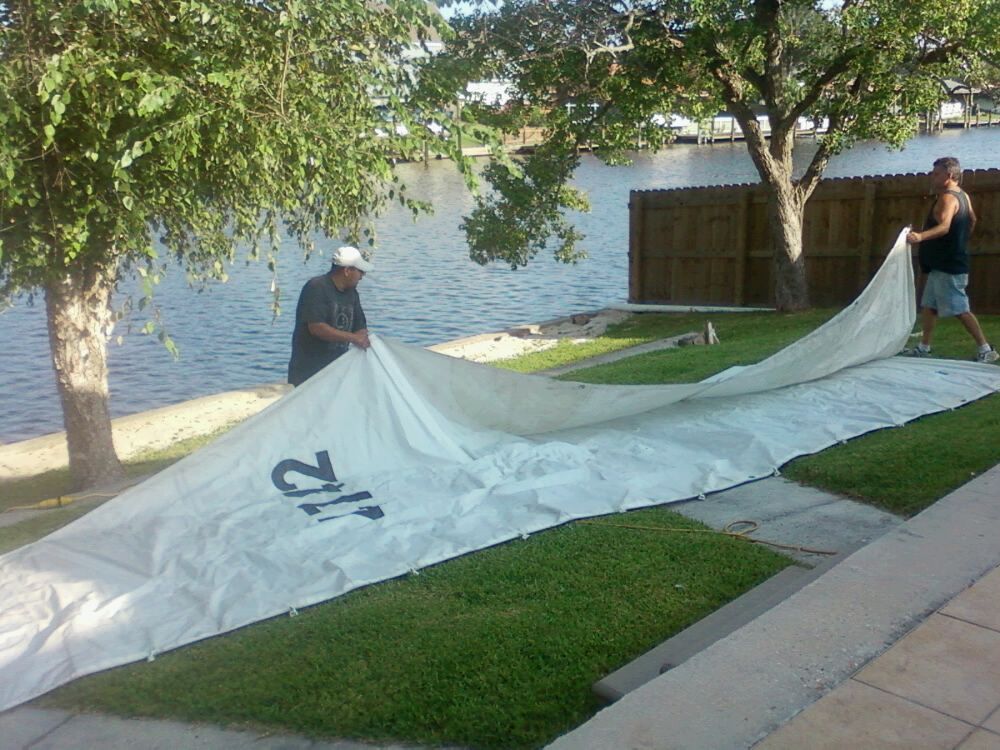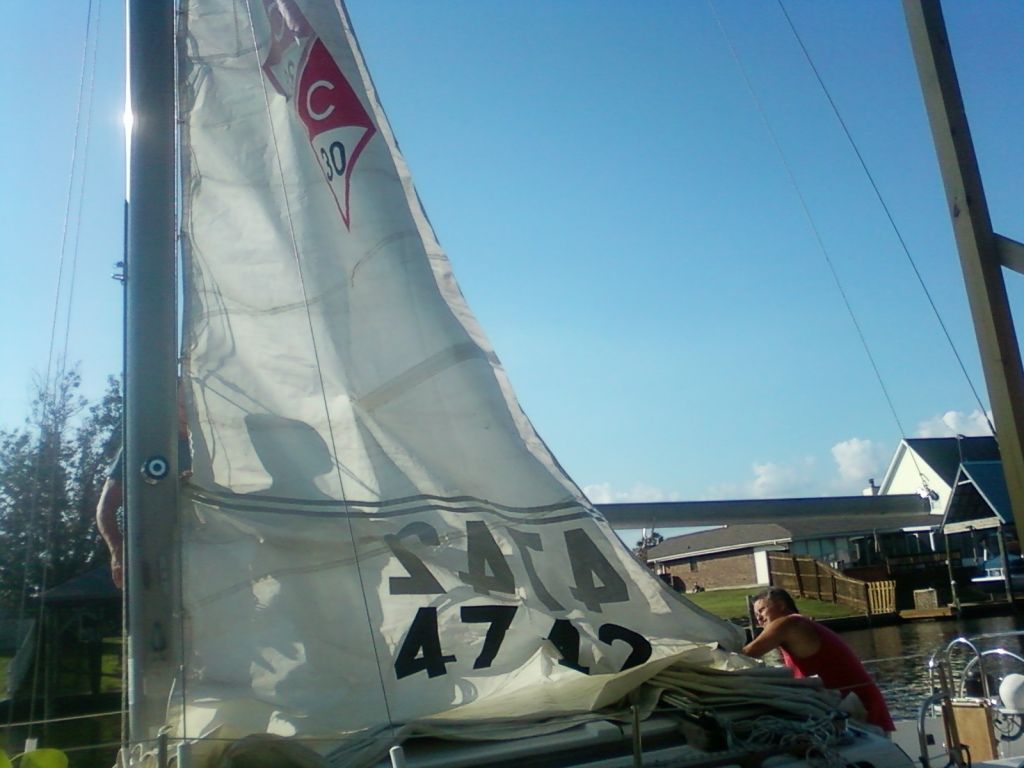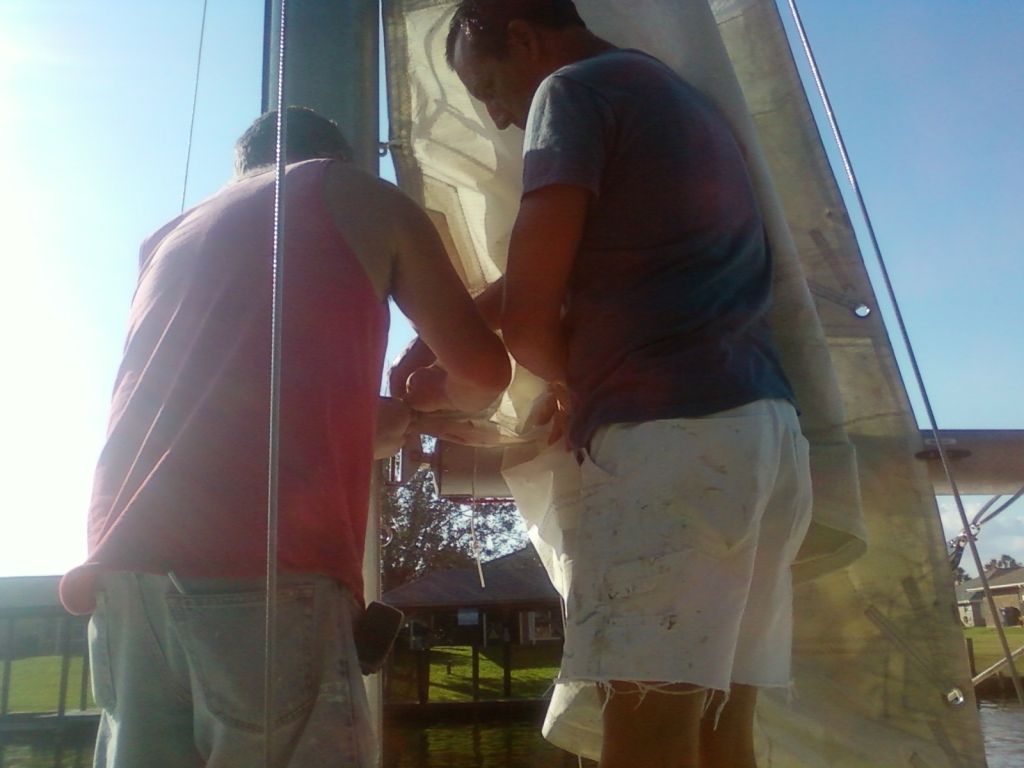Ted attaching the slugs of the main to the mast.
Before Robin came over for a sail pack fitting, Ken and our friend Ted had to put the main sail back on Nirvana. She's been naked since we stripped her for Hurricane Isaac, and we still need to put the head sail, bimini and grill back on. Removing and replacing the main sail was a good learning experience, since it was a first for us.
Folding the main sail for the hurricane ... a lot bigger on the ground!
Our main sail luff (front of sail) is attached to the mast with slugs (little pieces of plastic) that slide into a track on the mast.
Attaching the tack (bottom of the luff) to the mast.
I don't know the proper terms, but it appeared that the tack was attached to the mast with some sort of locking pin. I need to find out ... now this is bugging me. The back of the sail (clew) is then attached to the back of the boom with something called a carabiner ... a metal loop with a sprung gate. We have a loose-footed main, so there are no slugs or bolt rope to worry with.
While watching Ken and Ted attached our main sail, I also learned that we have four "battens" in our sail. They don't go fully across the sail, and they start at the back (leech). They are about 3 ft long and appear to be made of some sort of fiberglass material. The battens are inserted into pockets sewn into the sail. Evidently, there are "full-batten" sails, "partial-batten" sails and "no-batten" sails. Of course, I had to look up battens to find out their purpose. The battens help support the shape of the roach. What's a roach? Although the sail is mainly a triangle, it's got an arch of extra material at the top of the leech ... that's called a roach.
I've learned so much from this experience. Before this, I had no idea that a leech or a roach were anything more than some nasty bug! I also could have never told you what a tack, clew, batten or carabiner meant. It's all coming together. I think we are visual beings, and watching the sail being attached really helped me retain the terms.
Some of you may be very familiar with these terms, but for those who aren't ... I hope this helps!
Some of you may be very familiar with these terms, but for those who aren't ... I hope this helps!
Hasta luego ... until then. Mid-Life Cruising!


















9 comments:
Good stuff! Thanks for sharing. I'm still in the process of learning and researching everything I can, so kudos for spreading some knowledge.
Siochana,
Mike
I admit that I still get confused about those terms. I can remember the 'luff' because we use the term 'luffing' a lot when the sail isn't trimmed correctly. So it gets reinforced many times.That's what it takes for my brain to retain the information, apparently.
When we first entertained the idea of learning to sail and buying a boat, I don't think I really knew the endeavor would also include learning a new language. I know there are so many other things to master: weather patterns, tides, currents, engine maintenance, fuel systems, electrical, plumbing, provisioning, etc. but the language of sailing seems to be one of the first things to master, and if you don't already have some if the associated uses and when's and how's - it can be difficult to attach the terminology to it's definition. At times, I feel overwhelmed. But every week, I absorb more, and it's all part of this adventure - stretching the brain, learning more about the boat, exercise the body as well as neural synapses, etc. It's all good. It's been done before - by every sailor out there... Every one of them started out learning the same stuff. With curiosity and determination, I think we'll all catch up. :)
Belinda, you're right! If so many others can get it, so can you and I ... all with time. At least that's what I'm telling myself ... LOL!
Wait until you have to take it down and put it back up while the boat is at anchor. Folding that sail on the deck of the boat is quite a challenge! On our boat, the genoa (jib) is the largest sail. That one is a real bear to get folded up on deck. Now that you have done it once, the next time will be much easier.
Hey, cool content, but WordPress breaks it up on my monitor. Maybe it's the plugin you have on the site. Have you considered a different CMS?
Thanks for sharing your great experience on how to remove and replace a main sail.
The reason you often find roachy main sails on higher performance boats is simple, the roach adds sail area to the sail higher up where the wind is stronger. On some of the higher aspect ratio sails that have a very large headboard, full battens and a lot of roach, the sail isn't really triangular anymore but more like a trapezoid.
However, you do have to be careful, since adding or removing roach from the main sail can shift the center of effort and change how much lee/weather helm the boat has.
Judy, I can only imagine trying to fold a sail on the bow of our boat! That should be interesting, and probably entertaining for anybody watching ... LOL!
Post a Comment